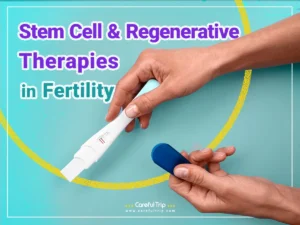
Advances in reproductive medicine continually reshape the hopes of those navigating infertility. Among emerging approaches, stem cell and regenerative therapies hold remarkable potential. Unlike traditional techniques that rely solely on hormonal treatments or donor gametes, these innovative methods explore the body’s ability to regenerate reproductive tissues or rejuvenate gamete quality—raising the prospect of restoring fertility where options were previously limited.
Though still largely experimental, stem cell-based interventions—ranging from ovarian rejuvenation to sperm quality improvement—have shown promising results in early studies. This article dives deep into what stem cell therapy for infertility involves, how it’s being applied in various contexts, what outcomes have been observed, and what the future may hold, including ethical and access considerations.
What Is Stem Cell Therapy for Infertility?
Stem cell therapy in infertility involves using undifferentiated cells—such as mesenchymal stem cells (MSCs), adipose-derived stem cells, or bone marrow–derived stem cells—to regenerate, rejuvenate, or repair reproductive tissues that contribute to fertility. Stem cells have the unique ability to self-renew and differentiate into specialized cell types, enabling them to address damage or dysfunction in ovarian tissue, the uterine lining, or even spermatogenic structures.
One Phase I clinical trial explored intra-ovarian transplantation of autologous adipose-derived MSCs in women with premature ovarian insufficiency (POI). The study found no serious adverse effects and showed promising signs of resumed menstruation and hormonal improvements in some participants. However, the results were inconsistent, underscoring the need for larger, controlled trials.
Animal studies have extensively demonstrated that stem cells can restore ovarian function by normalizing hormone levels, promoting follicle development, and in some cases inducing pregnancies [Ovarian Research].
How Stem Cells Are Used in Fertility Treatment (IVF, ovarian rejuvenation, sperm quality)?
Stem cells are being explored across multiple treatment applications:
- Ovarian Rejuvenation: Injecting stem cells directly into ovarian tissue has shown to increase follicle growth, hormone regulation, and even spontaneous or IVF-induced pregnancy in early human trials. For instance, one study reported ~68% oocyte activation, 7% spontaneous gestation, and 14% IVF-conceived pregnancies following stem cell treatment [Contemporary OBGYN].
- Enhancing IVF Outcomes: Stem cells may promote healthier follicle environments or better uterine receptivity. Research highlights improved embryo yields and embryo quality, which could translate into higher IVF success.
- Improving Sperm Quality: Although research is more limited, stem cells—particularly autologous cells—are being investigated to enhance spermatogenesis. One recent experimental procedure reintroduced preserved stem cells into the testes of a cancer survivor. While results are preliminary, the approach illustrates a promising frontier [1].
What Are the Success Rates of Stem Cell Fertility Therapy?
Because most studies remain experimental or in Phase I/II trials, large-scale success data are unavailable.
- A study involving ovarian stem cell therapy reported roughly 68% oocyte activation, 7% spontaneous pregnancies, and 14% IVF pregnancies.
- Another clinical report on autologous MSCs for POI noted increases in AMH and AFC (indicators of ovarian reserve) without serious adverse effects, and a 4% pregnancy rate over a three-month follow-up period [ijrcog].
- Preclinical animal studies consistently demonstrate ovarian function restoration, resumption of the menstrual cycle, and, in rare cases, successful pregnancies [PMC].
While early data are encouraging, they remain preliminary. Effectiveness varies between patients, and larger randomized controlled trials are needed before any definitive success metrics can be established.
Stem Cell Therapy for Women (POF, PCOS, Ovarian Failure)
Women facing conditions such as Premature Ovarian Failure (POF)/Insufficiency (POI), diminished ovarian reserve, or Polycystic Ovary Syndrome (PCOS) are receiving special focus in regenerative therapies.
- In POI, stem cells have the potential to regenerate ovarian tissue. Reviews summarize ongoing progress across different stem cell sources, with encouraging preclinical outcomes. Specific methods—including combining stem cells with platelet-rich plasma (PRP)—have demonstrated improved folliculogenesis and vascular regeneration in limited human applications [Herald Open Access].
- PCOS is another area where stem-cell-derived models are being developed for understanding disease mechanisms—like potential mitochondrial dysfunction—not yet directly therapeutic but vital for future regenerative strategies.
- Women with poor ovarian response are prime candidates for ovarian stem cell injections. Early case series show improved ovarian markers and occasional pregnancies, though long-term outcomes remain rudimentary.
Collectively, these applications point to a potentially transformative role for stem cells in restoring ovarian function in conditions previously deemed irreversible.
What Are the Cost and Availability of Stem Cell Fertility Treatments Abroad?
Stem cell fertility treatments remain highly experimental and are not widely available through standard reproductive medicine clinics. Some countries offer them as part of clinical trials or regulated experimental programs.
Costs are typically high, often ranging from $10,000 to $20,000 or more per procedure, depending on stem cell type, source, and complexity. Insurance coverage is rare, and most treatments are out-of-pocket. Availability tends to concentrate in research universities or specialized fertility centers offering advanced regenerative services.
Medical tourism may bring patients to countries like Iran, India, or Eastern Europe, where pioneering clinics may offer such treatments more affordably, albeit with varying regulation. When exploring these options, it’s crucial to verify legal standing, ethical oversight, and scientific reliability before proceeding.
Ethical Concerns and Future of Regenerative Medicine in Fertility
Ethical considerations in applying stem cell therapies include:
- Safety and Unproven Efficacy: Many clinics offer unverified treatments, raising concerns about patient exploitation. Regulatory bodies, including the FDA, caution against the marketing of unproven stem cells.
- Source of Stem Cells: The use of embryonic stem cells raises moral and legal concerns; therefore, most studies focus on adult-derived or autologous stem cells.
- In Vitro Gametogenesis (IVG): Advances like creating eggs from skin cells in mice hint at revolutionary potential—but bring substantial ethical, regulatory, and social complexities [The New Yorker].
- Long-Term Effects: Beyond immediate pregnancy outcomes, there’s limited data on impacts to offspring or parents. Prudent oversight is essential.
Looking forward, ongoing breakthroughs, like early human ovarian organoids and gamete replacement technologies, promise new horizons. Yet, these futuristic approaches must be grounded in ethical frameworks, robust science, and equitable access.
CarefulTrip’s Role in Stem Cell Fertility Therapies
For patients considering regenerative fertility options, platforms like CarefulTrip offer invaluable guidance.
- Facilitating Access to Specialized Clinics: CarefulTrip helps patients identify reputable providers offering stem-cell interventions within regulated environments, ensuring they navigate options safely.
- Education on Science and Ethics: By clearly explaining potential risks, benefits, and current scientific limitations, CarefulTrip promotes informed consent and realistic expectations.
- Comprehensive Support: In addition to medical coordination, CarefulTrip provides logistical support—travel, accommodation, language assistance—for those seeking treatment in medical tourism settings.
- Advocacy for Patient Safety: Through vetting of clinics and adherence to ethical standards, CarefulTrip acts as a safeguard against unregulated, risky procedures.
By bridging cutting-edge science with compassionate logistics and ethical accountability, CarefulTrip empowers patients navigating the complex landscape of stem cell fertility therapies.
Final Words
Stem cell and regenerative therapies represent a bold frontier in reproductive medicine, offering hope to individuals previously with limited options—POI, poor ovarian response, or male infertility, among others. Early studies show potential: some pregnancy outcomes, improved ovarian markers, and functional rejuvenation in animal and preliminary human models.
However, we remain in an early stage. Many treatments are experimental, cost-prohibitive, and regulatory landscapes are still developing. Strong ethical frameworks and more rigorous clinical trials are essential before these therapies become standard care.
For patients interested in this path, medical facilitators like CarefulTrip provide a necessary bridge—combining scientific clarity, patient-centered support, and access to cutting-edge, ethically vetted clinics abroad.
The future of fertility may very well lie in regeneration. But as with all promising science, it must move forward with caution, integrity, and a steadfast focus on patient well-being.
References
- “Stem Cells as a Resource for Treatment of Infertility-related …” Frontiers in Cell and Developmental Biology, 2019. The New Yorker
- “Current Status and Future Prospects of Stem Cell Therapy …” PMC, 2024. PMC
- “Stem cell therapy found to boost fertility in women with ovarian failure” Contemporary OB/GYN, July 2025. Contemporary OB/GYN
- “Stem cell-based therapeutic potential in female ovarian aging” Ovarian Research, 2024. BioMed Central
- “Recent trends in stem cell therapy for premature ovarian …” PMC, 2020. PMC
- “Stem Cell Treatment Shows Potential for Restoring Fertility …” Aging-US, Jul 2025. Aging-US
- “Stem Cell Therapy in IVF: A Handy Guide for Everyone” New Life Fertility Clinic blog. New Life Fertility Clinic
- “Use of autologous adipose‑derived mesenchymal stem …” Global Reproductive Health, 2023. Lippincott Journals
- “Effects of autologous stem cell therapy for fertility …” IJRCOG, 2023. IJRCog
- Time Magazine, “The Future of Fertility” on in-vitro gametogenesis (IVG). The New Yorker
- New York Post, “New groundbreaking procedure … reverse male infertility”. time.com
